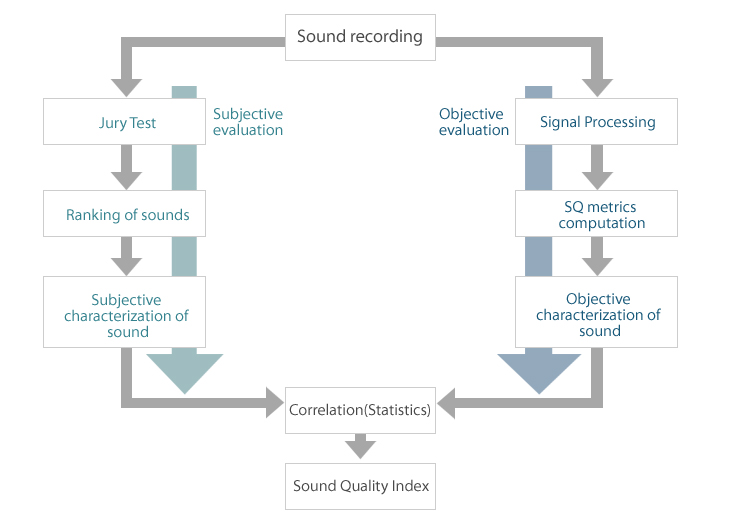Sound Qualitiy
The purpose of Product Evaluation
There are various criteria of product sound quality evaluation. The loudness or the uniformity of a sound could work as the dominating factor determining the quality of a sound. Or it could be the sharpness, the coarseness, even the operating time that works as the major criterion to determine the sound quality depending on the characteristics of the product sound. These criteria vary with product types, objectives of sound quality evaluation, ambient environments, and groups of users as well.
For example,deep and concise sound is generally evaluated as the most preferable sound for vehicle door close sounds whereas, pure and elegance sound with a long fade is generally recognized as the most preferable sound within bells. Another example is that for those of adolescents and mid-twenties and thirties tends to prefer sporty and deep exhaust systems on their vehicles but it could be very irritating and annoying for elderly.
The criteria of sound quality evaluation vary with various factors. As a consequence, evaluating quality of a sound for the product is crucial to satisfy the customer propensity nowadays. The objective of product evaluation is to develop an index that allows us predicting the subjective rate of the product sound by analyzing its sound characteristics.
To achieve this, the actual users’ sound preference is evaluated then impartial comparison between its result and the characteristic of its sound to identifying their correlation is utilized. We can take advantages of predicting customers’ sound preference between two different products by using the developed index to simply analyze the characteristics of its sound.
The procedure of Product Evaluation

The procedure of Product Evaluation

Human’s hearing system is frequency sensitive and its characteristics changes with the object sound level. Besides, humans’ ear sensationally hears the exact same sound with an equal energy differently and often be affected by the chronological occurrence of the event that causes the sound. In this regards, it is extremely hard to identify all the characteristics of sounds what human is actually hearing only with the decibel level of the sound. Therefore, various metric systems that can quantify and represent the characteristics of a sensational sound have been developed: The loudness which indicates the level of a sound, the sharpness which indicates the quantity of the sharpness of a sound, the roughness which indicates the level of coarseness of a sound, and etcetera.
All these metric has been developed through empirical experiments with various human subjects. Even though the characteristics and psychological effects of humans’ hearing system is taken into account when these metric was developed, we can’t place much reliance on them since the accuracy is still questionable. Thus, we ought to constantly put our effort to develop a new metric or find a way to improve existing metric for objectifying the sound characteristics.
